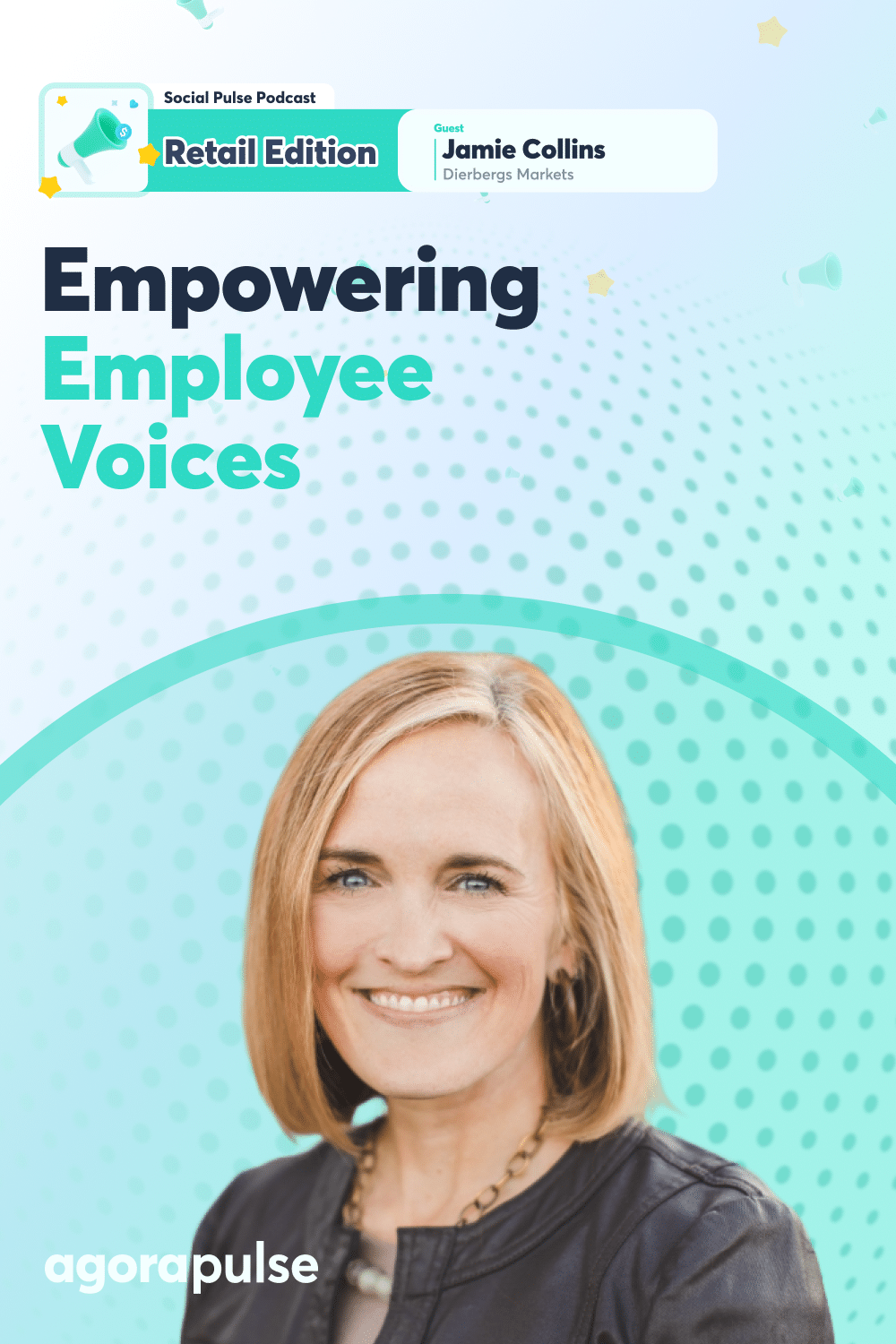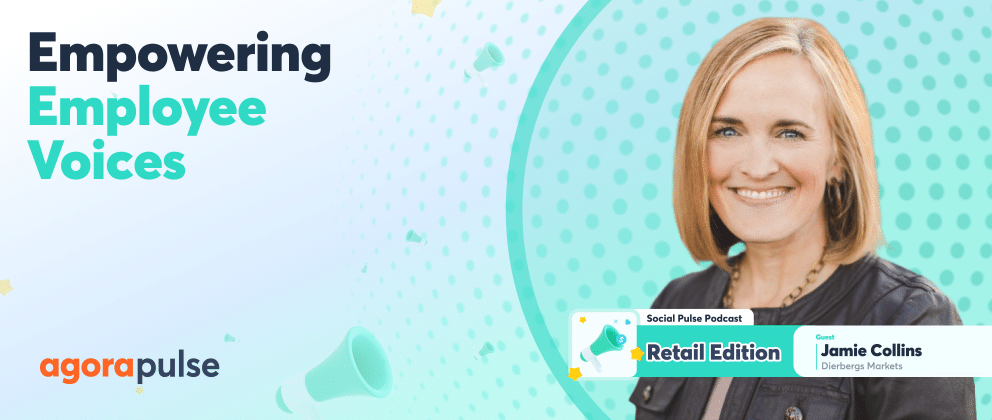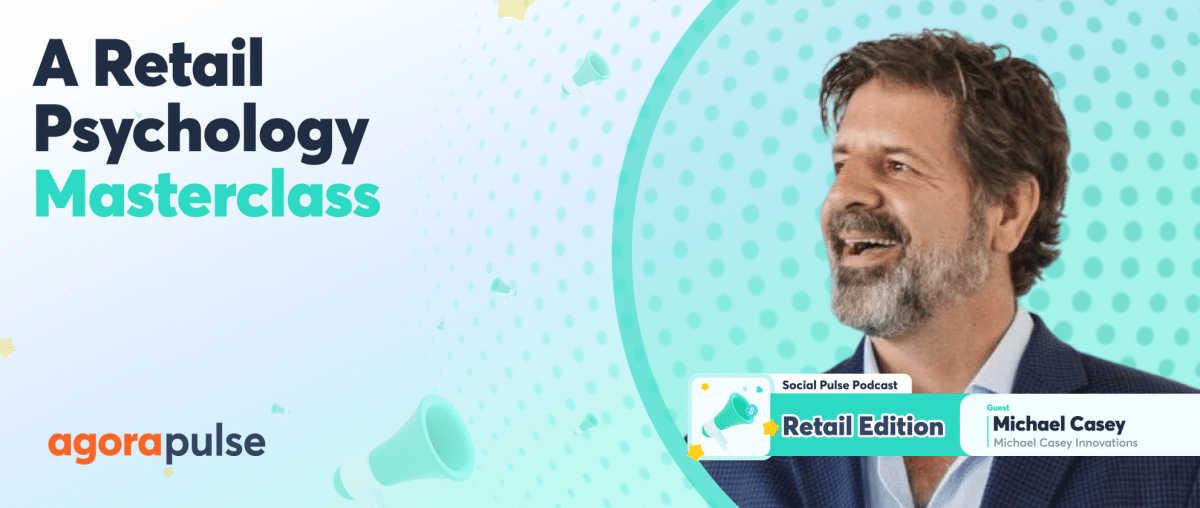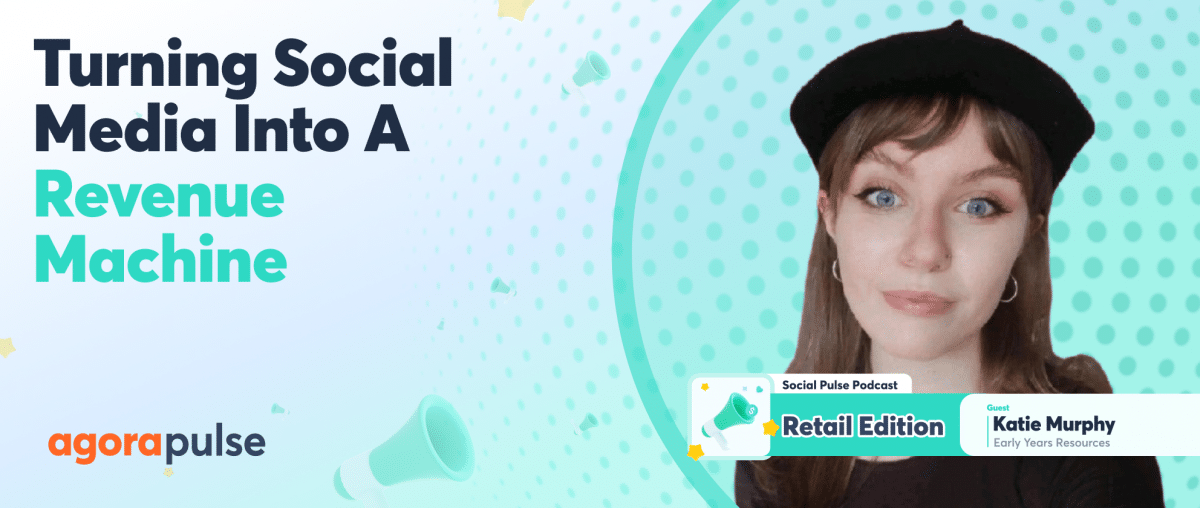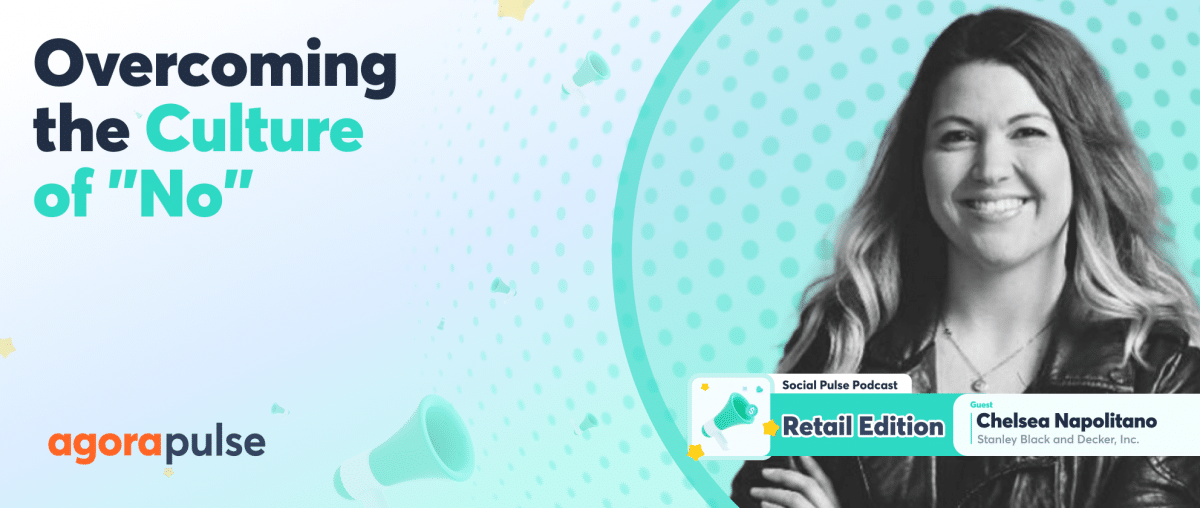The challenge for many retail marketers is cutting through the noise on retail social media and establishing genuine connections with their audience while mega influencers and celebrity endorsements might generate buzz. They often lack the authenticity and local credibility that today’s consumers crave.
How do you successfully implement an employee advocacy program? How do you empower your team members to become authentic brand voices while maintaining consistency and quality?
Today’s guest knows exactly how to unlock this potential. Your host and Agorapulse’s Chief Storyteller Mike Allton talks with Jamie Collins, a marketing leader at Dierbergs Markets in St. Louis. She has successfully transformed Dierbergs’s social media strategy by putting their employees at the center of their content. She’ll share how they’ve achieved higher engagement, stronger community connections, and more authentic brand storytelling to empower their team members to share their stories.
[Listen to the full episode below, or get the highlights of the Social Pulse: Retail Edition, powered by Agorapulse. Try it for free today.]
Retail Social Media Challenges
Can you tell us about some of the social media challenges that you were facing that led you to explore this strategy?
Jamie Collins: I think to do that, it probably helps to give you a little bit more of a situation of our company as a whole or the industry, even.
We’re an incredibly competitive industry. There is no shortage of grocery stores in this particular market—but there’s a lot more than that to procure food online, fast food, and convenience stores. There’s just no shortage.
The other thing in this market is people who live here probably see our company as a relatively large grocery chain when in reality, we’re only 27 stores.
But people’s perception is their reality. And so they need us to operate in a way that keeps us competitive.
So knowing we can’t reach everyone anymore because their share of wallet is going to different places, we lose an opportunity to continually stay fresh with those customer connections. So then we start thinking about, “Okay, there’s a lot of competition. What sets us apart? Our customers rank us high on quality, variety, and service.”
Keep up with BRAND NEW episodes of Social Pulse: Retail Edition.
“Well, our people are a tremendous asset when it comes to delivering against that service and projects that overall customer experience.”
Here’s the cool thing about our people: It’s not just the individuals that you’re interacting with should you step foot in our store, but it’s the people who are procuring the products or making the choice of what goes on our shelves. It’s the people that keep our stores clean. It’s the people who make up the recipes that go into our prepared foods that people love.
And so that way, for those that don’t experience us on the regular in-person—maybe they’re just choosing to get their groceries digitally or still kind of making a decision of where they’re going to spend their dollars and give their loyalty to—we can deliver some of the behind-the-scenes that goes on with our folks.
We can showcase some of the charm and spark that our individuals have in hopes that we can break through the clutter and start developing some affinity for Dierbergs.
Retail Social Media: Use of Employees as Advocates
Mike Allton: Now I know the use of employees as advocates—well, it might be popular in some industries. I’m not seeing it a whole lot in the retail space. It’s a relatively new concept.
How did management respond to the idea of using employee advocacy?
Jamie Collins: That’s an interesting observation that I guess I was not on top of because using our associates as an independent grocer is what differentiates us. And they are a big part of our story. They’re just an incredible asset. And so using associates was a no-brainer for us. It also was a huge win with our recruitment team, too, ’cause they’re like, gosh, if you show off our associates, you are getting the benefit of talking about a program or a product.
But we get the benefit of showcasing the types of individuals that work in our stores, that work in our facilities, and a little bit of the culture as well. And so it was a multifaceted approach there.
Mike Allton: I love that take because we’ve been doing something similar at Agorapulse. We have a social media management tool. Inside that tool is actually an advocacy feature so you can upload all of your employees, and you can designate what departments they’re from.
So what our HR team will do is if we’ve got a job opening in a particular department like the engineering department, they’ll create the job opening and use our tool. They’ll ask all the other existing engineers to share that job opening on their LinkedIn or their social network.
Again, it’s that same perception where if I’m a prospective engineer and I’m trolling LinkedIn for job opportunities. And I see an employee of a company raving about that company, and they’ve got a job opening that’s in line with my skill sets.
That’s a huge vote of confidence. That’s the kind of social proof I’m looking for. I might not be thinking consciously about it, but subconsciously, I know my mind is going to be more attracted to that than just a simple job listing amongst hundreds of others.
Deciding Who to Work With
Is it just anyone in the company that you might work with, like in the example I just gave, or are you thinking about very specific advocates or employees to tap?
Jamie Collins: We have a number of individuals that are our go-to’s that we’ve learned over the years that just have a comfort level behind the camera.
One of the individuals I want to spotlight is our CEO. He is one of our owners as well. And he is the top collaborator when it comes to creating content filled with associates. So he has turned into a bit of an influencer. It helps that his name is on the building. People see him as human and not just this person, you know, this name that they read about in the paper. And he likes to interact with our associates. He puts them at ease. And he makes it very conversational. And so he’s an easy one, Mike, to pick in terms of who we choose.
But then in terms of other people, it’s really reaching out, encouraging our management teams to say, “Who are those people with Spark? Who are the ones that have subject matter expertise?” Ones that get excited to talk about it with their coworkers—but as customers come through, let’s put a spotlight on them and help them tell their story or educate whatever the objective of the content pieces.
What we’re doing is we’re mining our group of people. We have about 3,500 associates. We mine for stories. Everybody has something that they enjoy.
As I mentioned earlier, they’ve got a favorite product or just something special about working for the company that they want to talk about.
Finding those connection points and hearing managers—what they have to say in terms of, “Hey, this person has done their due diligence.” They have subject matter expertise in salmon, or this person has just finished their curriculum to become a cheesemonger, so let’s figure out how we bring them in and talk about specialty cheese. They’re super-passionate about this. They want to educate others on how to select the right cheese for example.
But then we have this database of individuals, and they don’t all need to be put in front of the camera. It has to align with our content goals, too. And so are we wanting to talk about a product? Is it a recruitment effort? Is it a community partnership? Maybe we’re just showcasing people who are volunteering as a Dierbergs associate at a philanthropic partner, and then back to that comfort level in front of the camera.
So not everyone’s going to be willing to do that, right? If you force it, it’s going to backfire. You’re not going to get that natural feeling in front of the camera. And then some people that you think are going to be wonderful behind the camera still backfire, and that’s okay.
We’ve got 3,500 associates. There are bound to be enough people that we can tap into
Mike Allton: What I love is that there’s this subtle truth about why advocacy and even influencer marketing work and that’s that they’re word-of-mouth marketing. We as humans tend to trust other humans—not a nameless, faceless corporate brand.
So even whether it’s the CEO or somebody who works in the produce department, they’re showing up for their audience—whether it’s a small, medium, or large audience, they’re showing up authentically as that individual. They’re humanizing the brand, which was the point that you made very subtly, but amazingly when you’re talking about how the CEO is showing up and he’s putting that face to the brand. I love that.
Training for Retail Social Media
Are you getting into training and guidelines or boundaries or anything like that?
Jamie Collins: We have a group of individuals that run our social program, and so they’re understanding always what we’re looking for what’s gonna be on message. And so they’re kind of auditing any sort of response from an associate that they might interview from that standpoint.
I go back to: We’re not that big of a company. We are not that formal here. And that’s kind of one of the great things about working at a smaller company. If you just get to know people, I mean, we’re a big family and they’re just willing to have a conversation with you. There happens to be a camera turned on.
And I think the bigger deal [is]: We make people more nervous about it and it doesn’t feel as authentic. Whereas if you’re just capturing them at the moment in a very candid conversation, I think you get better content.
Could you give an example?
Jamie Collins: I talked about our CEO being a huge collaboration partner. We leveraged his influencing capabilities, and we called it behind the scenes, a little play on words there. And it was again, back to that collaboration with recruiting too. It was an opportunity for us to get him in the stores, in our facilities, and showcase to our customers. There are special people that do a lot of good work to make sure we’re delivering an excellent experience, good products, and good quality.
It also gave us an opportunity to talk about things that we may not get a huge platform for on the regular because we have so much to say. We’re a grocer, right? We have 40,000 active excuses at any given time, say, I mean there’s no shortage of content.
And so getting him into the stores and talking with that seafood manager like what’s your favorite thing about the department, what’s your favorite piece of fish. What do customers need to know about us? And they’ll talk about the seafood cook-free program really energized by it.
Greg Dierberg, who is our CEO, is a master at pulling out the really good nuggets of information that he feels are important for our customers to hear. We covered meat, we covered like a lobby wine program. We covered something in our central kitchen, our commissary where we make all of our prepared foods. He had the whole net on the coat, and the gloves, like he was on the lines with everybody kind of asking questions.
It was cool from an associate standpoint ’cause they’re like, “Oh my gosh, I don’t get to interact with Greg on a regular basis.” So they were excited to participate. He was excited to kind of roll up his sleeves and get into the work with people and understand what makes them tick.
You can see why our recruiting group liked it because they’re seeing that interaction amongst different components of our business.
And then marketing liked it and our buying team liked it because then we can showcase the cool products around the store that we have. And so from an evaluation standpoint, I wouldn’t say it was super-sophisticated, but we did monitor engagement. Is the juice worth the squeeze? It does take a little bit of time to organize. Hey, we’re going to be here. Can you have this interaction with Greg? And oh, by the way, can you be on camera?
And so there are some logistics that go into that, but we just watch comments and overall engagement, and if these things take flight a bit.
Maintaining Brand Voice Across Your Retail Social Media
Mike Allton: I imagine one of your main concerns is that the brand Dierbergs has a consistent voice and a consistent message across all platforms all the time.
I’m wondering how you balance that against employees out there saying whatever they want to say.
Jamie Collins: Well, I think you’re making the gross assumption that they’re just saying whatever they want to say (and maybe they are in their own personal channels) but in terms of the content that my department puts out, it’s definitely moderated.
Think about it this way: Our customer-facing associates, even without a camera in front of their faces, they’ve got the responsibility to represent our brand every single day in every single customer interaction.
And so if they’re not already doing a good job at that they’re probably not going to be interested in staying at Dierbergs for a while, you have to put that brand hat on at every customer interaction, not just from the ones we’re making digitally. But I mean, they have to be “on”. I have much admiration for the men and women who work in our stores because it’s got to be just amazing.
But it boils down to hiring, again, if we’re not bringing the right people in that can represent our brand, then we’re getting something wrong there.
And so that makes our job in marketing a lot easier too, because a lot of those individuals have already been vetted, right? And so we know that they’re going to take care of us by taking care of our customers.
I guess your question is an interesting one because it’s not something that I’ve been concerned about. And should somebody go rogue on camera, we have the power of editing, and we certainly don’t have to give them that airtime branded channels.
Mike Allton: Now that is such a good answer because what I’m speaking to there is a fear I think that a lot of employers have who haven’t done what you’re doing already. They haven’t already employed employee advocacy, and they’re having unfounded fears, right? Where you said it exactly: You are putting your trust in your employees. They’re employees for a reason, and particularly in an organization like yours, there are so many customer-facing employees that that’s why they were hired to talk to customers every single day in one respect or another. So they’re used to that, and they’re absolutely going to reflect your brand values and your brand voice. So that’s fantastic.
Jamie Collins: That’s why your comment earlier was very interesting to me that companies aren’t already tapping into their employees and as the advocates because they are the people on the front line. In a retail environment, they’re the people on the front lines, and they are the ones that are promoting, they may have just tried a new cinnamon bread that came in and somebody takes it and [says], “All of you have you tested this? I just brought that home and it is so good. You’re not going to be disappointed.”
That’s a very simple customer-associate interaction. It is a brand impression. Our employees are advocating for our product in that example. And so you know, it’s things like letting our associates try new things when they come in helping them understand the why like, “Hey, we’re bringing this new program in. Here’s why we think it’s cool. Here’s why we think the customers are really going to like it.”
So there’s a lot of training, too, that goes behind the scenes. I’m just fascinated that retailers don’t do this more often.
Mike Allton: Yeah, it’s something I actually see a lot and it’s not exclusive to retailers. I mean, just think about the restaurants that you’ve been to. How many times do you ask the waiter or the waitress? You know, what do you recommend or what’s good here? And sometimes they have a really great answer. Oftentimes they don’t have a good answer, it usually boils down to their own initiative.
Very few restaurants actually take the time to train their wait staff and help them know what’s great and what’s not, how to give good recommendations, and how to answer that question correctly. It’s just up to the individual. And so they get great tips and the other ones don’t. Right.
Jamie Collins: It’s funny. We just started testing out a bit of a series where we are doing our own sampling on social and just in trying to get like those raw reactions, we’ve pulled in some associates to some of them, and some of the responses are pretty funny. Sometimes they make the cut, sometimes they don’t, but we’re trying to even bring them in, in terms of, look, I’m actually eating the product that we brought, and it’s new and it’s good.
Mike Allton: Well, no, that’s great. I think if people take themselves out of the grocery perspective and just think generally speaking, you know, the strategies and the tactics that you’re advocating for are phenomenal.
Specific Tools/Resources for Retail Social Media
Everybody should be looking for ways that they can incorporate these into their businesses.
For folks who haven’t done something like this before, are there specific tools or resources maybe that you found most helpful in managing these kinds of programs?
Jamie Collins: So honestly, I would start with your company leadership. I can speak from a retailer standpoint. We have 27 stores, we have 27 store leaders. We have management within those stores. They are witnessing the people who are going to have that spark on camera. They’re able to nominate people. So use your own associates or employees as your number one tool.
But then I would say what’s worked for us is having one or two individuals that really kind of know what you’re looking for too, in terms of content. So that’s where we send out a retail social media manager to do the filming. She’s understanding, okay, I know we really want to talk about the quality of this new beef program we brought in and so they might be prompting the associate with questions, but not leading if you will, like they, they just want to make sure that the associates were able to comment on the right things.
Just go in with a plan of what you want to get from a content standpoint, and then in terms of figuring out who is available or can fill your pipeline, you have to leverage the leaders within your organization.
Mike Allton: It’s fascinating. So I know predominantly speaking, most advocacy activities, like the ones that we’re talking about today, they’re pretty much going to live and breathe on retail social media. They’re not going to be in communities or organizational meetings. That’s not what this approach is for.
Measuring Success and Impact
So how are you measuring any kind of business impact that these retail social posts and these retail social media advocates are having to address?
Jamie Collins: Well, I would love to sit here and tell you we’re incredibly sophisticated within our metrics on this. We continue to evolve and get better when it comes to utilizing associates. If we’re not always evolving then it just can’t get better. And so we certainly see engagement numbers spike. I mean, the number of comments and the shares I would also tell you our associates are on social platforms too.
And so they’re helping boost those numbers, which is getting that content out to people. But there’s an internal metric, too, where it’s kind of interesting. It’s an internal pride point; it’s people saying…you know, I was in a store this morning, we were doing our merchandising walkthrough for the holiday. And this woman was was super excited. She goes, I’m so excited. You let me dance in this video and talk about this program. And I had to laugh … My friends and my family and my coworkers are commenting on it. And so just to see her get excited about being a part I don’t know that you can put a business metric on that, but maybe a bit of employee satisfaction or retention perhaps.
But it comes down to from a content standpoint, did we achieve what we wanted? I look at our brand ambassador program. Which are not associates. They may be honorary associates. I look at them as building impressions with an audience we probably wouldn’t have gotten to speak with you otherwise.
The same with associates. Impressions matter. If we’re talking about a new product if we’re talking about a new program or if we’re just getting excited about a new technology that we’re bringing, our customers and our associates are demoing it or talking about it, it is. For us right now awareness and impression building.
Mike Allton: That makes a lot of sense. That is huge I think for a business like yours in this market, like you mentioned the CEO talking to the gentleman in charge of the seafood department. And you know, maybe they’re looking at cuts of salmon or something like that. I’m not gonna jump in my car and drive Dierbergs at that moment to buy that. But the next time I’m meal planning, I might recall that and think, “I know Dierbergs has some great salmon choices. Maybe I’m going to include that in next week’s meal plan.” And that’s the kind of exposure repeatedly that every brand like yours needs to get out there.
Final Advice for Retail Social Media
What other advice would you share? Do you think other retail marketers want to start empowering their employees as social media advocates?
Jamie Collins: Well, if I can go just back one minute through that comment ,you just said:
Years ago, when social media wasn’t a thing, people would walk into our stores, and if they had a question, they would ask, “How do I cook this fish? Or what’s the difference between this salmon and this salmon or this kind of meat versus this kind of meat?”
There was a lot more dialogue and engagement that was happening in our stores, and that’s still happening to some degree.
But in general, the younger the customers get, the more they want to just interact with what’s on their phone, not interact with our customers. Or maybe they feel there for whatever reason, they don’t feel comfortable asking a question. And so being able to tap into that knowledge and share that because otherwise, if they’re not going to ask, how would they know? Or they could say, “Oh, I saw you talking about the salmon. Tell me more.”
It humanizes the person on the other side of that sounds silly. Cause they’re humans on the other side of the counter, but it humanizes the Dierbergs brand to say, “Okay, this is maybe a company that I can go and get some tips on how to cook this kind of meat or whatever. It gives me a face. A familiar face, so when I do walk into the store, maybe it’s a little bit less intimidating.” I hope that there’s a piece of that happening as well.
- Understand what you want to communicate, first of all. Like I said, we have so much to talk about. You could go in and just create thousands of stories. But you can’t boil the ocean, right? You can’t talk about everything, and resources are limited.
- Know what you want to talk about first when you go into that store, but get in stores tap into that management network.
- Understand who are the people that are going to be excited to talk about a product, and build that pipeline.
- Don’t be afraid to tap into people more than one time because you start developing that familiarity with your audience and the associates.
The associates who like to be behind the camera are going to want to do it again and again for you. They tend to reinvent themselves.
They’ll surprise you when you go and talk to them.
Thanks for reading the highlights from this episode about retail social media. Don’t forget to find the Social Pulse Podcast: Retail Edition on Apple where we’re digging into the challenges, successes, and stories of social media and community professionals in the industry, just like you. Subscribe to gain valuable insights that you’ll be able to apply to your own work and social presence from each and every episode.
